By the Numbers
Report finds $1.1 trillion in energy savings due to U.S. natural gas production
AJOT | October 22, 2019 | Energy | By The Numbers
Natural gas end-users, which include American households, businesses, manufacturers, and power generators, have realized $1.1 trillion in savings since 2008 as a result of increased natural gas production in the Shale Crescent USA region (Ohio, Pennsylvania and West Virginia), according to a new economic analysis released this week.
FTR reports a rebound in trailer orders in September
AJOT | October 21, 2019 | Intermodal | Trucking | By The Numbers
Trailer order activity rebounded from the recent doldrums as some fleets began placing orders for 2020.
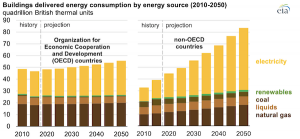
Global energy consumption driven by more electricity in residential, commercial buildings
AJOT | October 21, 2019 | Energy | By The Numbers
Energy used in the buildings sector—which includes residential and commercial structures—accounted for 20% of global delivered energy consumption in 2018.
FBX Update: Will the recent tariff deferral boost demand?
AJOT | October 18, 2019 | Maritime | By The Numbers
While the latest tariffs were deferred, the impact to date on small US businesses, both in profitability and sourcing behavior has been significant.
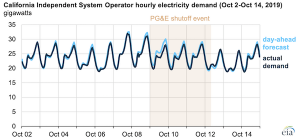
EIA’s Hourly Electric Grid Monitor shows effects of California wildfire-related shutoffs
AJOT | October 18, 2019 | Energy | By The Numbers
Starting on Wednesday, October 9, 2019, California electric utility Pacific Gas and Electric (PG&E) shut off electricity to hundreds of thousands of customers in 34 California counties.
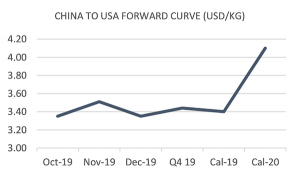
FIS Air Freight Report October 14, 2019
AJOT | October 14, 2019 | Air Cargo | General | By The Numbers
Some market positivity in the second week of Q4 as China to Europe and China to US gain a collective 11 cents (2.70% and 1.23% respectively) as airlines peak season rates will kick into action. The biggest aggregate gainer remains Shanghai to Europe, gaining another 8 cents and up 5.76% since the end of September.
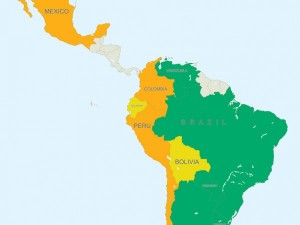
The unfulfilled promise of the Latin American decade
George Lauriat | October 14, 2019 | International Trade | By The Numbers
The Latin American Decade never quite took hold. The U.S.-China trade war is both an opportunity and a threat while the region’s trade pacts all face challenges that could mark their undoing. But a new decade is approaching, will the region be ready for another bid?
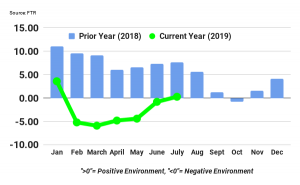
FTR Trucking Conditions Index for August reflects mediocre environment for carriers
AJOT | October 11, 2019 | Intermodal | Trucking | By The Numbers
FTR’s Trucking Conditions Index for August, at a -1.11 reading, was negatively impacted by weak utilization and higher financing costs. FTR forecasts that the TCI will hover around the neutral range through 2020.
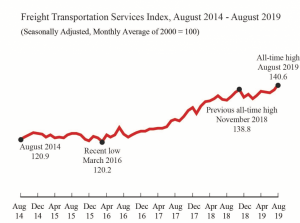
August 2019 Freight Transportation Services Index (TSI)
AJOT | October 10, 2019 | Air Cargo | General | By The Numbers
From August 2018 to August 2019, the index rose 4.1% compared to a rise of 5.5% from August 2017 to August 2018

Rystad: All eyes on the Caribbean as replacement ratio dips to the lowest in decades
AJOT | October 09, 2019 | Energy | By The Numbers
Oil and gas companies have discovered 7.7 billion barrels of oil equivalent (boe) year-to-date, according to Rystad Energy’s latest global discoveries report.
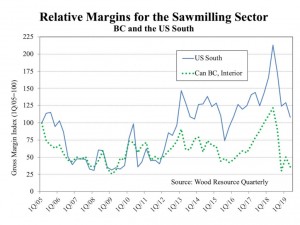
North America sawmill margins drop to 15 year low
AJOT | October 09, 2019 | International Trade | By The Numbers
Sawmill profit margins have fallen substantially in North America over the past 12 months with BC sawmills margins in the 2Q/19 being close to their lowest levels in 15 years, reports the Wood Resource Quarterly Costs for sawlogs declined in most major regions around the world in the first half of 2019. However, lumber prices have fallen faster in key markets resulting in lower profits for sawmills, particularly in British Columbia, the US South and Eastern Russia, according to the Wood Resource Quarterly. Seattle, USA. Lower lumber prices and only small adjustments in sawlog costs in the 2Q/19, sawmills in North America saw their profit margins decline again after a short-lived improvement in the 1Q/19. Although margins have fallen quite substantially in the US South the past year, reaching a three-year low, they are still higher than the 15-year average as tracked by the WRQ. Small changes in log costs together with lower income from lumber and residual sales have taken the gross margins for sawmills in British Columbia down to their lowest levels since the Global Financial Crisis back in 2009. In the 2Q/19, these margins areless than half of their ten-year average (see chart).
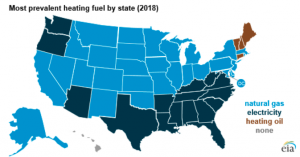
Winter energy bills in the United States likely to be lower than last year’s
AJOT | October 08, 2019 | Energy | By The Numbers
On average across the United States, households can expect heating expenditures this winter (October through March) to be lower than last winter’s, according to the U.S. Energy Information Administration’s (EIA) Winter Fuels Outlook, released at noon today.
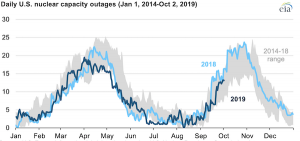
U.S. nuclear outages remained low in summer and moderate in September
AJOT | October 04, 2019 | Energy | Alternative | By The Numbers
U.S. nuclear electric generation plant outages averaged 2.7 gigawatts (GW) during the summer of 2019 (June through August), about the same as during the summer of 2018.
FTR reports North American Class 8 orders for September stuck in down cycle at 12,100 units
AJOT | October 03, 2019 | Intermodal | Trucking | By The Numbers
FTR reports preliminary North American Class 8 orders for September at 12,100 units, up 13% m/m but down 72% y/y. Class 8 orders continue to track in the 10,000-13,000-unit range for the fifth month in a row.
FTR’s Shippers Conditions Index for July reflects mainly positive market conditions for shippers
AJOT | October 03, 2019 | Intermodal | Trucking | By The Numbers
The SCI reflects a mixed freight environment with the industrial sector flat or worse, but consumer spending is still healthy. Firmer freight rates in July contributed to the decline in the index.

August non-OPEC unplanned oil production outages fell to lowest level since at least 2011
AJOT | October 01, 2019 | Energy | By The Numbers
Unplanned oil production outages among countries outside the Organization of the Petroleum Exporting Countries (OPEC) fell to 64,000 barrels per day (b/d) in August, the lowest level since the U.S. Energy Information Administration (EIA) began tracking global production outages in 2011.
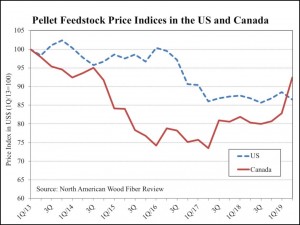
Wood fiber costs for US pellet manufacturers fall in Q2
AJOT | October 01, 2019 | International Trade | Commodity | By The Numbers
Wood fiber costs for US pellet manufacturers fell in the 2Q/19, while Canadian pellet producers experienced higher costs due to reduced supply of sawmill residues, reports the North American Wood Fiber Review
Drewry: Taming volatility
AJOT | September 30, 2019 | Maritime | Liner Shipping | By The Numbers
Tight control over Asia-ECSA capacity helps drive freight rate gains despite weak demand prospects.
South Africa Trade Surplus at 8-Month High as Mine Exports Rise
Bloomberg | September 30, 2019 | International Trade | By The Numbers
South Africa’s trade balance swung to its biggest surplus in eight months in August as mining exports surged.

Most wind capacity in the United States is designed for a medium wind speed environment
AJOT | September 27, 2019 | Energy | Alternative | By The Numbers
Most wind turbines in the United States were designed for medium wind environments, according to data collected in the U.S. Energy Information Administration’s (EIA) Annual Electric Generator Report. Wind design classes, as defined by the International Electrotechnical Commission (IEC), range from Class 1 (high wind) to Class 4 (very low wind).
© Copyright 1999–2024 American Journal of Transportation. All Rights Reserved
